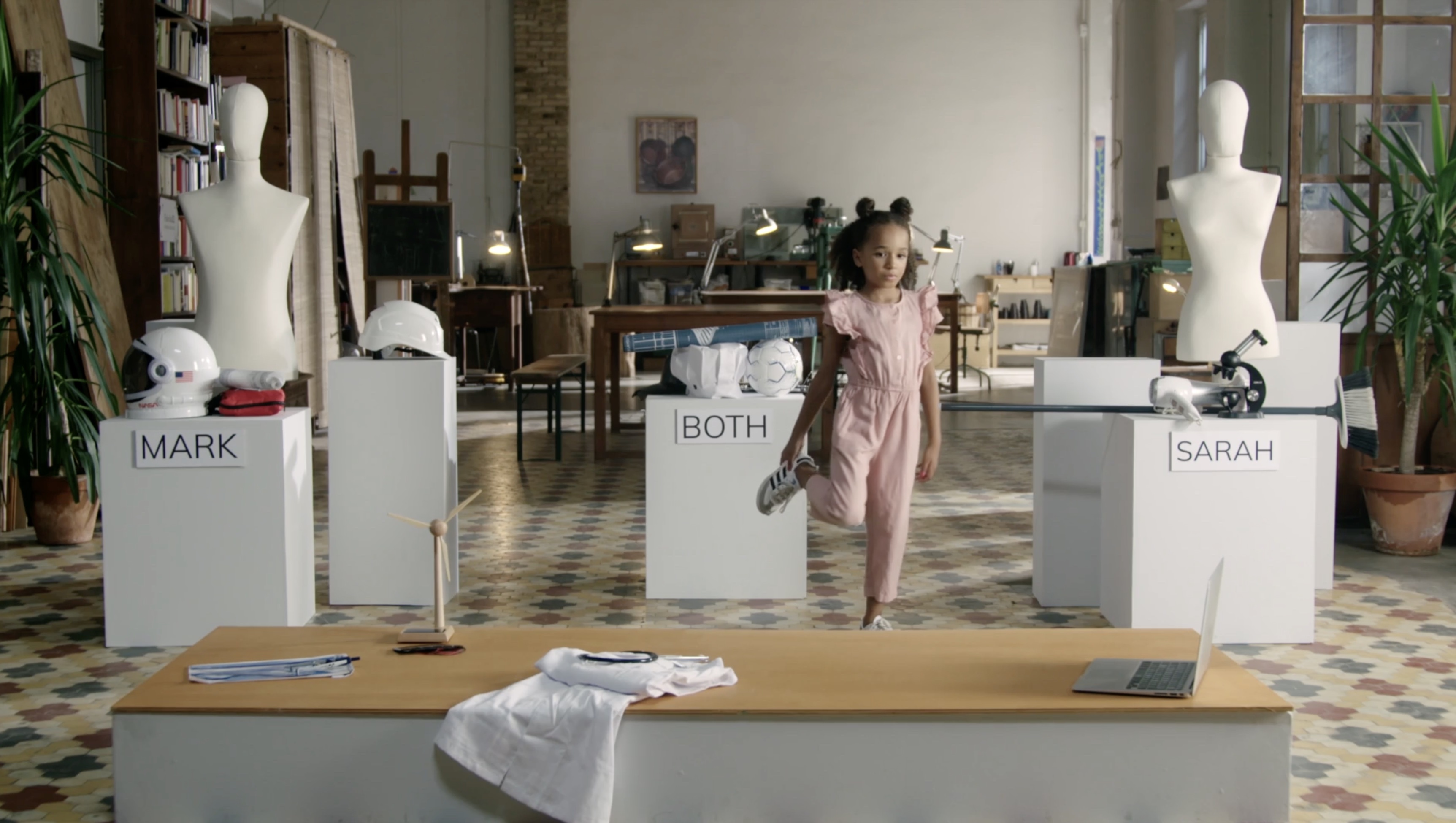Believing there's a way to teach boys and a different way to teach girls is the first step in growing up believing there are jobs for boys and different jobs for girls. But by perpetuating these stereotypes, we are promoting bias and limiting people’s futures. After all, what girls will even consider a career path in an area they have never heard of or have grown up being told, "This is not for you, this is for boys"? And the same also applies in the other direction!
Today, these stereotypes, even if they are identified and the need to combat them is obvious, are still too evident, particularly in the access girls have to certain areas, such as STEM.

Recognising the problem to work on solutions
The inequality between men and women in STEM subjects is undeniable and there is still a long way to go before we achieve equal rights and opportunities.
According to the World Economic Forum's Global Gender Gap Report 2021, it will take 136 years to eliminate the gender gap in STEM professions, and this figure has been increasing rather than decreasing: in 2018, the same report said it would take 118 years.
This gap is also noted by UNESCO, which sees it advancing around the world, where only 28% of researchers are women. This is in line with the United States Census Bureau's January 2021 report, which states that women account for roughly half of the US workforce, but only 27% of those working in STEM professions. However, this figure is trending positively: in 1970, women made up only 8% of those working in STEM areas.
This discrepancy is apparent in earlier years, even in school. According to the American Association of University Women, only 21% of engineering graduates are women, with this figure dropping to 19% in computer sciences. This discrepancy extends to pay: on average, men's wages in the STEM professions are $15,000 higher per annum than those of women working in the same fields.
The North American picture is mirrored in other countries, such as the United Kingdom, where, according to data from the Higher Education Statistics Agency, while the percentage of graduates in STEM fields continues to grow, women still only account for 26%. This figure is even lower in the job market: 24%. In Portugal, the picture is even worse: only 14.4% of women are engaged in technology according to the Portuguese Women in Tech community.
Whether through inspiring conversations with parents, friends and teachers; books, videos or podcasts; or through the will of each person; if everyone – boys and girls – is free to dream and fight for their dreams, whatever they may be, then we open up a world free from prejudice and full of opportunities.
Do you want to be a #REBELSFORCHANGE?
1. Don't limit yourself
Do you want to change the world? The first step to being and doing whatever you want in your life is to believe that you can. And you can! Science, Technology, Engineering and Mathematics can be the way for you to do this, as they work every day to improve the lives of many people across the world. Curing disease? Enhancing national security? Overcoming climate change? These are just some of the things STEM professionals are working on.
Our suggestions:
Women in Tech Podcast - Presented by Espree Devora, founder of WeAreLATech, this podcast seeks to inspire women to get involved in tech, by saying: if they can, so can I.
Sadie Sprocket Builds a Rocket, Sue Fliess e Annabel Tempest - No one has yet gone to Mars until little Sadie Sprocket decides to do so. To achieve her goal, Sadie reads everything she can and puts together an infallible team for the space mission: her soft toys. A book that demonstrates nothing is impossible.
2. Ask questions and get answers
This is the basis of the scientific endeavour: asking questions and looking for solutions, exploring the world, whether in the middle of the jungle or with a microscope in a laboratory. If you're a curious person who likes to solve problems and know how things work, then never limit yourself. All questions are valid.
Our suggestions:
Invisible Women, Caroline Criado Perez - In this book, Caroline Criado Perez shows how algorithms and information systems are defined to identify the male as the standard and the female as atypical. How can we overcome discrimination?
Her Stem Story - Launched in 2017 by Prasha Dutra, an Indian woman who moved to the US to pursue a career in chemical and mechanical engineering, this podcast dedicates each episode to a woman's story and her journey in STEM.
Olga y la Extraña Criatura Sin Nombre, Elise Gravel - In her room, Olga has a laboratory and dreams of being a scientist and a zoologist, but everything becomes more real when she discovers a strange creature. A book that is an ode to love for animals and to difference.
3. Do your own research
Only you can choose your future. Research is essential for understanding the world of opportunities within your reach. Research documentaries, books, visit university websites and platforms like Design The Future, where you can find your professional path. Don't be afraid to ask questions. In your family, in your circle of friends, among your teachers, is there anyone connected to the STEM professions? Talk to that person, ask them about their everyday life, how to get there and the possibilities that are opened up by studying these areas of knowledge. You can also ask questions of people you don’t know. Platforms like LinkedIn can make it easy for you to approach people you admire. Who knows if someone you admire can't be your mentor?
Our suggestions:
The future of Science is Female, Zara Stone - As important as the achievements of women in STEM areas is their journey. Turning to stories of women who are shaping the 21st century, in this book Zara Stone shows how success is made of joy, drama and euphoria.
Futureproof Your Career - With more than 200 episodes hosted by Elise Stevens, this podcast shares tips, tools, techniques and processes in order to encourage young people and women to pursue a successful career in STEM.
As Cientistas, Rachael Ignotofsky - A book filled with fun illustrations that tells the story of 52 outstanding women, from ancient times to the present, involved in the fields of science, technology, engineering and mathematics.
Tips for whoever wants to help the next #REBELSFORCHANGE
1. Smash stereotypes and demonstrate diversity
The world is diverse and different genders and cultures can be better represented in STEM professions. Demonstrating this diversity and smashing stereotypes encourages girls to project themselves in certain places and with certain professions. Identify and talk about women who have changed the world, promoting them as role models. For parents, educators and teachers it is important to begin by recognising their own misconceptions and combating them. And never, ever, disparage a boy playing with a vacuum cleaner or a girl who likes to take apart toy cars.
Our suggestions:
Aida Batista, Cientista, Andrea Beaty e David Roberts - Aida Batista has an insatiable curiosity, so much so that her parents, tired of her incessant questions, end up grounding her. A book that shows us we should never clip children’s wings.
10 Women Who Changed Science and the World, Catherine Whitlock e Rhodri Evans - The history of science is also made up of women, and to prove it Catherine Whitlock and Rhodri Evans have written mini-biographies of scientists like Marie Curie, the first woman to receive the Nobel Prize for physics.
Girls AND Boys Need STEM Education - In this TedTalk, Giewee Hammond shows the importance of involving boys in the idea that the future of STEM is equally female.
2. Talk about STEM at home and at school
For girls to be able to find work in science and to work in very technical professions (often unknown even to adults), it is important that they have contact with this world. Talking about these professions as realistic options that are within their reach is crucial if children and young people are to be able to include them in their range of choices. It is also important to take younger children to science and mathematics clubs, ATLs, science museum programmes and other programmes that may show them new career paths.
Our suggestions:
The Most Magnificent Thing, Ashley Spires - A girl decides to build the most magnificent device ever invented. Trying and failing leaves her desperate, and she ends up giving up. But her best friend, a dog, doesn't give up on her and convinces her to go for a walk to let her regain her strength and rediscover her inspiration. It is a story about resilience.
17 Mujeres Premios Nobel de Ciencias, Hélène Merle-Béral - A book containing the stories of women who have won the Nobel Prize in STEM areas, from the pioneer Marie Curie to the present.
3. Help break the fear of maths and science
The idea that you are not good at these subjects can be a social construct, as can the lack of girls’ confidence in their ability to succeed in scientific subjects. It is important to convey that confidence in yourself and instil in girls the idea they can master any subject. Furthermore, there are lots of successful people in STEM areas who didn't love mathematics at school.
Our suggestions:
The Women in Tech Show: a technical podcast - Over more than 100 episodes, software engineer Edaena Salinas talks to women working in the most varied areas of technology, sharing career advice for STEM areas.
Rosie Revere: Engineer, Andrea Beaty e David Roberts - A book for young children, with illustrations that show little Rosie Revere having adventures in the world of invention. Where many see rubbish, Rosie sees inspiration, encouraging younger readers to imagine possible worlds.

